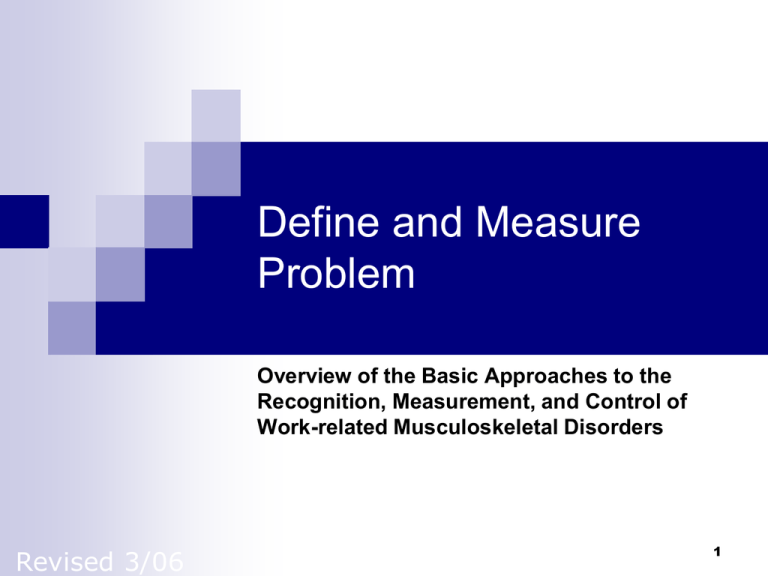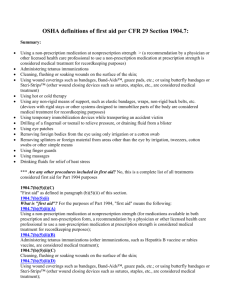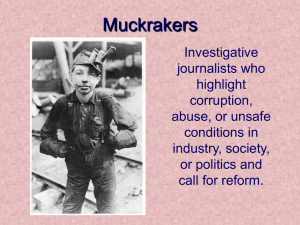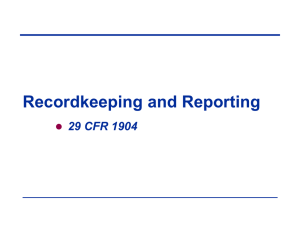Slide Presentation - Georgia Tech OSHA Consultation Program
advertisement

Define and Measure Problem Overview of the Basic Approaches to the Recognition, Measurement, and Control of Work-related Musculoskeletal Disorders Revised 3/06 1 Organization of the Rule Subpart A - Purpose Subpart B - Scope Subpart C - Forms and recording criteria Subpart D - Other requirements Subpart E - Reporting to the government Subpart F - Transition Subpart G - Definitions 2 Recording Criteria Subpart C - Recordkeeping Forms and Recording Criteria 1904.4 Recording criteria 1904.5 Work-relatedness 1904.6 New case 1904.7 General recording criteria 1904.8 Needlesticks and sharps 1904.9 Medical removal 1904.10 Hearing loss 1904.11 Tuberculosis 1904.29 Forms 3 1904.4 – Recording Criteria Covered employers must record each fatality, injury or illness that: is work-related, and is a new case, and meets one or more of the criteria contained in sections 1904.7 through 1904.11. 4 1904.29 - Forms OSHA Form 300, Log of Work-Related Injuries and Illnesses OSHA Form 300A, Summary of WorkRelated Injuries and Illnesses OSHA Form 301, Injury and Illness Incident Report 5 6 Incidence Rates Formula for calculation N Rate per 100 full time workers = x 200,000 Hours worked 7 Injury Analysis Frequency (Total Recordable Case Rate) Severity (DART Rate) Upper Extremity WMSDs Tendon Disorders Tendonitis Tenosynovitis Lateral Epicondylitis Medial Epicondylitis Ganglion Cysts Nerve Disorders Nerve entrapments Carpel Tunnel Syndrome Neurovascular Disorder Hand Arm Vibration Syndrome Thoracic Outlet Syndrome Location of Upper Extremity Disorders Overview of Symptoms Ganglion Cyst Synovial sheath swells and holds fluid Often seen in the wrist as a bump Epicondylitis (lateral and medial) Unsheathed tendons become irritated Pain that extends from elbow through forearm Overview of Symptoms Tenosynovitis Swelling of the synovial sheath Pain and swelling Tendonitis Tendon becomes inflamed Pain, swelling, weakness, tenderness Overview of Symptoms Nerve entrapments Carpel tunnel syndrome Swelling of the tendons in the wrist area that place pressure on the median nerve Symptoms include pain, numbness, and tingling of the hand (thumb and first 3 digits) Overview of Symptoms Neurovascular disorders Thoracic Outlet Syndrome Compression of the nerves and blood vessels of the neck and shoulder Symptoms like CTS extending up the arm Hand Arm Vibration Syndrome Disorder of the small vessels and nerves of the fingers and hand Results from vibrating hand tools Localized blanching at the fingertips with numbness on exposure to cold or vibration Back Pain 2nd leading ailment that affects the 25–50 age group Back injuries account for ~ 20% of all workplace injuries and illnesses Costs $20-50 billion a year The Spinal Column •7 cervical vertebrae •12 thoracic vertebrae •5 lumbar vertebrae •5 sacral vertebrae •4 coccygeal vertebrae The Basics Two Basic Structures 1. Vertebrae 2. Discs Injuries of the Back Pinched nerves Static postures, improper posture Acute trauma Pulled Muscles Heavy lifting Improper lifting technique Symptoms of Back Pain Pain (dull, consistent and sharp) Numbness Tingling Aching What if I do not have MSDs www.bls.gov A Proactive Problem-Solving Approach 1. Look for Clues 2. Prioritize Job Improvements 3. Make Improvements 4. Follow-Up Body Part Discomfort Map Body Part Discomfort Map Body Part Discomfort Map Look for Clues – Observe Work Activities o o Physical Work Risk Factors o Lifting/forceful movements, awkward postures, whole body vibration o Unnecessary handling of materials Symptomatic Worker Behaviors o Fatigue, discomfort, ‘pain behaviors’, etc. o Increased absenteeism, turnover rates or complaints and reduced morale o Workplace Design Issues o Are workers modifying tools, equipment, or workstations on their own? o o Malfunctioning equipment Productivity Issues o Production bottlenecks, reduced level of quality, missed deadlines, increase in waste/scrap, etc. Look for Clues – Use Assessment Tools o o Checklists o General Ergonomics Evaluations o Risk Factor / Activity Specific Task Analyses Early Detection Program
![Platelayer transcript [PPTX 40.48KB]](http://s2.studylib.net/store/data/015052336_1-ce13c9373e0ebfa8fa59df5818b52562-300x300.png)










